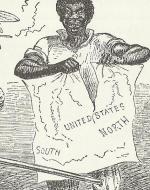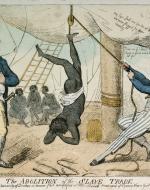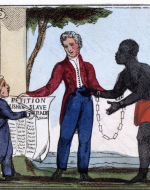Created by Tyler Butler on Sun, 04/14/2024 - 21:14
Description:
There has always been a struggle for the rights of African slaves for as long as there has been white people stealing them from their respective lands. Naturally as the movement itself grew and more people freed themselves, anti-slave movements began to pop up all across the nation, especially those in the North where discussions often took place for abolishing the act. Tensions would often rise between the enslaved and the slavers, causing the birth of many pro slavery messages, art pieces, and advertising. The constant pushback didn’t just push the freed slaves into high gear, but amplified their creative pursuits and ability to convey their points to a greater audience. The desire for emancipation was higher than ever, and the works of artists and writers needed to make sure their lesson was made clear.
A shining example of this drive comes from Henry Johnson’s “The Black Man’s Burden”, a response to Rudyard Kipling’s “The White Man Burden.” Whereas the latter’s poem was primarily focused on trying to maintain the status quo and telling white people that their actions to protect the black man would not be understood, Johnson’s poem is a response designed to showcase the struggles of a black man during this time. He highlights the constant struggle that comes with losing your culture and home, and the dehumanization that often accompanies slavery. The poem simutanesously displayed exactly the main issues with Kiplings interpretation. His goal wasn’t just simply to showcase the slaves struggles, but the ways the white man can often ignore or showcase a lack of care for the plight of those lesser than themselves.
This gallery exhibit is designed to showcase the many ways people wanted to convey the anti slave sentiment through art. Each piece of art showcases the way slaves are used and how they negatively affect the needs of both black people, as well has how the wider nation will sufer if they continue enslavement. No matter how drastically different each image is, they all contribute to the anti abolitionist movement.
Sources:
The black man’s burden by reverend H.T. Johnson. CommonLit. (n.d.-a). https://www.commonlit.org/en/texts/the-black-man-s-burden
The white man’s burden. The Kipling Society. (2024, April 7). https://www.kiplingsociety.co.uk/poem/poems_burden.htm
FIle 1: "Dis-United States Nmaahc." (n.d.). 1820–1861, the coming of war. 1820–1861, The Coming of War | National Museum of African American History & Culture. https://www.searchablemuseum.com/1820-1861-the-coming-of-war-2
This image depicts a core idea that was presented through the need for the abolishment of slavery. A constant belief that the nation would be constantly torn and cause tons of in fighting, solely due to a need for slavery. The North and South would constantly be at war for their desires to enslave and control the black population. This cartoon depicting the black man in the middle showcases how the world sees the man, while also making it clear there needs to be a change made. The North is depicted as sophisticated due to trying to abolish the act, while the South has very traditional farmer esuqe design to display their old ways. Something so simple should not cause such turmoil, and yet the world (mainly the south) was still caught up in the classic ideas and not against the future. A nation cannot be built on the constant conflict between inhuman acts.
Blow for Blow depicts the main idea of what slaves need to do to their masters. The portrayal is simple and yet the point is clear. There is no ifs ands or buts to the conflict. Freedom at this pont wasn’t going to come naturally, and the people needed to fight back and make sure they gain their rights to freedom. The image is barbaric in it’s presentation, but that is likely in part to wanting to convey a more blunt perspective of the conflict. To wait and to let somebody take reigns of your freedoms will be for naught, and fighting back is the best method. Nobody wants to be shackled, so instead of waiting why not use those talents to go in and fight for what you want. This tactic was especially effective, in large part due to many slaves physically becoming stronger because of the grueling labor they were put through.
In this image, we get to see a very blatant and obvious display of cruelty to those who are taken for enslavement. The dangling of the child like a prop is such a powerful but useful sentiment for displaying just how much the white people will view blacks as slaves. It helps that the setting is a tradition slave ship, getting across the lack of humanity found in the the transportation and movement of black people across the world. Given the climate and laws that were often used to make black people look less than human, it’s no surprise that the illustration wants to use that as a stepping stone to convey just how disgusting the act of enslavement is to the populace. Exaggerating the ideas as much as possible is necessary in order to make sure that someone looking at the art has a clear understanding of the message, and the black child’s treament sells it more than ever.
The illustration here gives those unaware of the problems in our society a picture of the clear inequality at place. On the left, a rich powerful white man is granted the ability to write in the laws and rules that often lead to slavery. On the right is a black man being prevented my the man in the middle which is used to show the constant prevention of black people from fighting for their rights. The said man in the middle being the president, who is being depicted as a person favoring the rights of the rich and powerful compared to the unkempt black slave. The clear intent is to convey just how loopsided the nature of our rights are, and a soft call to action for people to sway and fight against the higher white class. The president being in the middle is a way of making it very clear that there is no chance the highest power will help them in these struggles.





